Billy E. Warrick (Retired)
Professor and Extension Agronomist
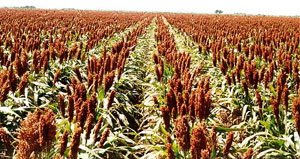
TABLE OF CONTENTS
- Introduction
- Sorghum Seed
- Identifying Stages of Growth
- Emergence
- Three-leaf Stage
- Five-leaf Stage
- Growing Point Differentiation
- Flag Leaf Visible
- Boot Stage
- Half-bloom
- Soft-dough
- Hard-dough
- Physiological Maturity
- Summary
- Acknowledgment
Introduction
Sorghum is an importance crop grown in West Central Texas. In our area the grain is primarily used as a livestock feed, however, in some regions of the world it serves as a human food.
To manage the sorghum crop for maximum production, the producer must understand how the plant grows and develops. Management practices used by producers prior to planting until the crop is harvested can affect its growth, development, and nutrient uptake. The “Grain Sorghum Production Handbook” from Kansas State University (C687) gives a good overview of most of the production considerations.
The information provided below describes the general growth and nutrient accumulation pattern of the sorghum plant and divides the growth of the plant into several identifiable stages. Management practices that should be considered and implemented at each plant growth stage is discussed. Information will center on the plant and its production needs. The choices made by producers can and will impact the crops development.
In general, most of the grain sorghum planted in our area is a hybrid. The hybrids available vary in plant height, drought resistance, maturity, insect resistance, openness of head and color of grain; just to mention a few differences. Most producers select from hybrids available and choose those that have shown to be adapted to our environment and provide consistently high yields. The producers that generally have the highest yields are those that understand how the plant grows and develops.
Once the basic growth pattern of grain sorghum plants is understood, it is much easier to anticipate problems and judge the merit of changing a management practice.
Identifying Stages of Growth
Growth and development of the grain sorghum plant are described only in general terms in this publication. Hybrids grown at other locations would follow the same general growth pattern. The specific timing between growth stages and number of leaves developed at later growth stages may vary among hybrids, seasons, or locations.
Some definitions of plant parts are necessary to identify various stages of plant development described in this publication. Figure 1 shows a young sorghum plant and an older plant. Some of the early stages of development are defined by the number of fully developed leaves. The older plant in Figure 1 has parts identified that occur later in the season. Several lower leaves have been lost.
A leaf is counted when the collar (the point where the leaf blade and leaf sheath, attach) is visible without tearing the plant apart. The young plant shown has three fully developed leaves. Identification of individual leaves early in the growing season may also be aided by considering the shape of the first (lowest) leaf. The first leaf produced by the sorghum plant has a rounded tip. If the lowest leaf on the plant is pointed, then at least one leaf has been lost.
Stages shown and discussed range from emergence until physiological maturity. Time required to reach each stage depends both on the hybrid and the environment in which it is growing. The times presented are for comparative purposes only. They would change for the same hybrid at the same location if planting date were changed or if results from two seasons were compared. Other factors such as soil fertility, insect or disease damage, moisture stress, plant population, and weed competition may also affect both timing of the various stages of development and condition of the plants at each stage of development.
Figure 2. shows the pattern of growth (dry weight) and nutrient accumulation during growth of sorghum plants. Note that dry matter, nitrogen, phosphorus, and potassium all are expressed on the basis of total weight of each factor so that all reach 100 percent at maturity. It is important to recognize that nutrient uptake curves fall above the dry matter curve for most of the growth period. For example, half-bloom is reached at approximately 60 days after emergence–about one-half of the total plant weight has been produced–however, nearly 60 percent of the phosphorus, 70 percent of the nitrogen, and 80 percent of the potassium already have been taken up. Those percentages emphasize how important early growth stages are in the nutrition of the sorghum plant.
Growth of the various plant parts–in terms of dry weight–is shown in Figure 3. The first 30-35 days after the plant emerges, nearly all growth is leaves. Then the culm or stalk starts rapid growth, and leaves and stalk continue until maximum leaf weight is reached at about 60 days and maximum stalk weight at about 65 days. After about 50 days the head increases in weight rapidly. Then following pollination the grain increases in weight rapidly, sometimes faster than the rate total dry matter accumulates. That results in a net decrease in the stalk weight as materials are moved from the stalk to the head.
In considering descriptions of stages of growth that follow, the effects of management practices, insect or hail damage, fertilization, weed control, or other practices can be best understood by keeping Figures 2 and 3 in mind.
Sorghum Seed
Sorghum seed are small when compared to corn and soybeans. It also varies greatly in seed size. Shown in the photograph are seed from two different hybrids. If these hybrids were planted by weight of seed per acre, one would be seeded much thicker than the other. For example, the following table shows what would happen if both of these hybrids were planted at 4 pounds per acre and each had 75 percent field establishment.
Table 2. Effect of seed size on planting rate and plant population
when planting is based on pounds per acre.
| Example | Weight of 1,000 seeds (grams) |
Number of seed per acre planting 4 pounds |
Number of plants per acre with 75% emergence |
| Hybrid #1 | 19.0 | 95,500 | 71,600 |
| Hybrid #2 | 34.3 | 52,900 | 39,700 |
So to obtain the desired plant population, it is necessary to know more than how many pounds per acre to plant.
| Stage of growth | Management Guide |
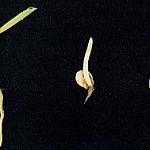 EmergenceWhen the plant first breaks through the soil surface (generally occurs 3 to 10 days after planting). EmergenceWhen the plant first breaks through the soil surface (generally occurs 3 to 10 days after planting). |
Depth and date of planting greatly affect emergence rate. During this period, growth depends on the seed for nutrients and food reserves.Planting should be timed so that germination and early growth occur during warm temperatures and so flowering will occur before the hottest period of summer. The time required for emergence is impacted by soil temperature, moisture conditions, depth of planting, and vigor of the seed.Cool, wet conditions during this time may favor disease organisms that seriously damage stands. Seed should be treated with a fungicide before planting.Weed control should be considered. Producers have pre-plant, pre-emergent, and/or post-emergent herbicides available for use. Herbicides are generally used due to the problems encountered with hoeing or cultivation of large fields. This is very apparent in years with above average rainfall, when mechanical practices are limited by wet soil conditions. |
 Three-Leaf StageLeaves are counted when the collar of the leaf can be seen without tearing the plant apart. The collar is the area where the leaf blade and leaf sheath attach. Three-Leaf StageLeaves are counted when the collar of the leaf can be seen without tearing the plant apart. The collar is the area where the leaf blade and leaf sheath attach. |
It is important that the date of planting be late enough so that sorghum can grow rapidly during the three-leaf stage.While the plant’s growth rate depends largely on temperature, this stage usually will occur about 10 days after emergence.Since the plant is quite small, relatively slow growth and poor weed control can seriously reduce yield.As the growing point is still below the soil surface, much of the leaf area can be removed (by hail or insects) without killing the plant. However, sorghum does not recover as vigorously as corn. |
 Five-Leaf Stage Approximately 3 weeks after it emerges a sorghum plant has 5 leaves fully expanded; its root system is developing rapidly and roots produced at the lower nodes may push the lower leaf off the plant. This usually does not cause difficulty in identifying the five-leaf stage because the lower leaf has a rounded tip and the second leaf is pointed (Figure 1). |
The growing point is still below the soil surface so leaf loss will not necessarily kill the plant.Regrowth is more vigorous than at the three-leaf stage but still less vigorous than corn.During the five-leaf stage the potential for the plant to develop is determined.Weed competition, nutrient and water stress, or other problems such as insect damage at the five-leaf stage, can seriously reduce yields if they are not corrected.The plant enters its “grand period of growth” in the five-leaf stage. Dry matter accumulates at nearly a constant rate until maturity, if growing conditions are satisfactory. |
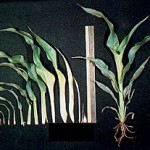 Growing Point DifferentiationAbout 30 days after sorghum emerges. About one-third of the total leaf area has fully developed; 7 to 10 leaves depending on maturity class. The lower 1 to 3 leaves may have been lost. |
Growth and nutrient uptake are rapid during the growing point differentiation stage. Adequate supplies of nutrients and water are necessary to provide maximum growth.Growing point changes from vegetative (leaf producing) to reproductive (head producing). The total number of leaves has been determined and potential head size will soon be determined.Sorghum plants are now quite competitive which helps maintain good weed control the remainder of the growing season.Time from planting to growing point differentiation generally is about one-third of the time from planting to physiological maturity (maximum dry weight). |
 Flag Leaf Stage Following growing point differentiation, rapid culm elongation and rapid leaf development occur simultaneously until the flag leaf (final leaf) is visible in the whorl.Most leaves are fully expanded except the final 3 to 4 leaves. |
About 80 percent of the total leaf area is present. Light interception is approaching maximum.The lower 2 to 5 leaves have been lost. Any reference to leaf number from now on should be from the top, counting the flag leaf as leaf number 1.Growth and nutrient uptake continue at a rapid rate. While only about one-fifth of the total growth has occurred, nutrient uptake is far greater with more than 40 percent of the potassium already being taken up. Adequate supplies of nutrients and water are necessary to provide maximum growth.The head is developing.Sorghum plants are now quite competitive which helps maintain good weed control the remainder of the growing season. |
 Boot StageAll leaves are now fully expanded, providing maximum leaf area and light interception. The head has now developed to nearly full size and is enclosed in the flag-leaf sheath. Boot StageAll leaves are now fully expanded, providing maximum leaf area and light interception. The head has now developed to nearly full size and is enclosed in the flag-leaf sheath. |
Rapid growth and nutrient uptake are continuing.Severe moisture stress or herbicide injury during the Boot Stage may prevent the head from exerting completely from the flag-leaf sheath. This prevents complete pollination at flowering time.Except for the peduncle (see Figure 1) culm elongation is essentially complete.Peduncle elongation is beginning and will result in exertion of the head from the flag-leaf sheath.Potential head size has been determined. |
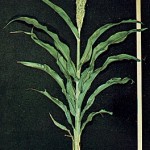 Half-bloom is usually defined as when one-half of the plants in a field or area are in some stage of bloom. However, because an individual sorghum head flowers from the tip downward over 4 to 9 days, half-bloom on an individual plant is when the flowering has progressed half-way down the head.Time required from planting to half-bloom depends on the maturity of the hybrid and environmental conditions; however, it usually represents two-thirds of the time from planting to physiological maturity. |
Following the boot stage the peduncle grows rapidly extending the head through the flag-leaf sheath. Even in combine sorghums, the peduncle is not reduced in length as is the rest of the stalk. Although height of combine-sorghum plants has been reduced, heads are well above the leaves, which makes combining easier.At half-bloom approximately one-half of the total dry weight of the plant has been produced. However, nutrient uptake has reached nearly 70, 60, and 80 percent of total for N, P2O5, and K2O, respectively.At this time grain formation begins; therefore, any limitation in plant size, leaf area, or plant numbers can no longer be corrected.If environmental conditions are favorable, the sorghum yield can still be increased by increasing the seed weight.Sever moisture stress can result in “blasting” and poor head filling.As mentioned earlier hybrid maturity and planting date should be chosen so flowering will not occur when severe hot, dry weather is normal. |
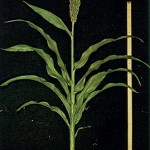 Soft-Dough StageBetween half-bloom and soft-dough the grain fills rapidly; almost half of its dry weight is accumulated in this period.The stalk weight increases slightly following half-bloom; then, because grain is forming rapidly, the stalk loses weight. The loss in stalk weight may account for as much as 10 percent of the grain weight. |
Final yield depends on the rate that dry matter accumulates in the grain and the length of time that it accumulates.As long as the hybrid is able to mature before frost, the dry matter accumulation will be high if environmental conditions are favorable.The selection of later maturing grain sorghum hybrids has an advantage over early maturing varieties if: 1) the hybrid can mature before frost and 2) flowering does not coincide with severe moisture stress.Dry matter accumulation rates do not vary much among hybrids.Nitrogen and Phosphorus uptake is still rapid and Potassium uptake is close to 90 percent and starting to decline.Lower leaves are still being lost with 8 to 12 functional leaves remaining. |
 Hard-Dough Stage By hard-dough stage, about three-fourths of the grain dry weight has accumulated. |
Nutrient uptake is essentially complete.Severe moisture stress or a freeze before the grain matures will result in light, chaffy grain.The stalk has declined to its lowest weight.Additional leaves may have been lost. |

|
 Physiological maturity can be determined by the dark spot on the opposite side of the kernel from the embryo. The kernel on the left is physiologically mature; the one on the right is not.To reap maximum yields of silage or high-moisture grain, harvest as near to physiological maturity as possible.The plant will not reach physiological maturity and proper moisture content for normal harvest at the same time.The time required between physiological maturity and a grain moisture suitable for harvest depends on the hybrid and weather conditions.Stalk weight may increase slightly near physiological maturity.After physiological maturity, the remaining functional leaves may stay green or die and brown rapidly. Nutrient uptake is basically complete. Physiological maturity can be determined by the dark spot on the opposite side of the kernel from the embryo. The kernel on the left is physiologically mature; the one on the right is not.To reap maximum yields of silage or high-moisture grain, harvest as near to physiological maturity as possible.The plant will not reach physiological maturity and proper moisture content for normal harvest at the same time.The time required between physiological maturity and a grain moisture suitable for harvest depends on the hybrid and weather conditions.Stalk weight may increase slightly near physiological maturity.After physiological maturity, the remaining functional leaves may stay green or die and brown rapidly. Nutrient uptake is basically complete. |
Nutrient Uptake
Nutrient uptake precedes dry matter accumulation because nutrients are required for growth and dry matter accumulation. Figures 4, 5, and 6 shows nutrient uptake (nitrogen, phosphorus, potassium) and distribution among various sorghum plant parts during growth. Figure 2 shows that on a relative basis potassium is taken up most rapidly followed by nitrogen, then phosphorus.
Large quantities of nitrogen and phosphorus and some potassium are translocated from the other plant parts to the grain as it develops. Unless adequate nutrients are available during grain filling this translocation may cause deficiencies in the leaves and premature leaf loss which may decrease yields. Thus an adequate supply of nutrients at all stages of development of the plant are necessary for maximum yields.
A large portion of the nitrogen and phosphorus but only a small portion of potassium is removed in the grain. Amounts removed depend upon the amount of each in the plant. A 135-bushel-per-acre grain crop contains (in the total above ground plant). 185 pounds of nitrogen, 35 pounds of phosphorus, and 215 pounds of potassium. If the entire plant is harvested for silage or other forms of feed, much more potassium is removed because most of it is in the vegetative part of the plant.
Sorghum grows slowly the first 20-25 days (five-leaf Stage) with the above ground part of the plant entirely leaves. As number of leaves and amount of leaf area increases, growth rate increases. Then in the next 35 to 45 days the remaining leaf area of the plant develops and expands to provide the photosynthetic, or manufacturing, apparatus for grain production.
Most leaf growth occurs between the Growing Point Differentiation Stage and the Boot Stage. Also, during this time the upper 8 to 10 leaves develop. Starting about half-way through the period when leaves are produced, the culm starts to elongate and grows rapidly in length and weight until flowering occurs. Then the grain fills rapidly, using materials being manufactured by the leaves and being moved from the culm into the grain.
The general pattern of dry matter accumulation is the same for different sorghum hybrids. Later-maturing hybrids tend to be heavier at each stage of development than early maturing hybrids, particularly from Growing Point Differentiation Stage to maturity. Total dry matter accumulation rates for 3 hybrids grown in 2 years was 170 pounds per acre per day during the “grand period of growth” (Flag Leaf Stage to near Physiological Maturity). The 3 hybrids had nearly identical rates of dry matter accumulation; the later one produced longer and thus yielded more.
Highest yields can be obtained only when the hybrid selected is adapted to the area and when environmental conditions are favorable during all stages of plant development.
Summary
The preceding illustrations show how a sorghum plant grows and takes up nutrients. They show the rates at which growth and nutrient uptake occur. The period of growth in which each plant part is produced is shown. Where nutrients are located in the plant at various times is also indicated. Using such information helps us provide conditions to help obtain maximum rate of dry matter accumulation for the longest period of time appropriate for an area. For best results:
- Select high quality, vigorous seed of adapted hybrids
- Fertilize according to soil tests for production realistically expected
- Plant at the proper time and at both correct population and spacing
- Control weeds, insects, and diseases
- Provide optimum moisture conditions possible
- Carry out other cultural practices with the general growth and nutrient uptake of the plant in mind
Finally, use the information on growth and nutrient uptake as you look back on your last crop to determine what practices might be changed or to evaluate any new practices or products.
Acknowledgment
The original publication that inspired this page was written by R. L. Vanderlip, Agronomist with the Department of Agronomy, Kansas Agricultural Experiment Station. He expressed appreciation to the Kansas Fertilizer and Chemical Institute, Inc., the Hail Insurance Adjustment and Research Association, and the Crop Insurance Research Bureau. Also, he thanked Garst and Thomas Hybrid Corn Co., Inc for there support. Recognition was also given to the work by graduate students, particularly H. Eugene Reeves and Merle D. Witt.
